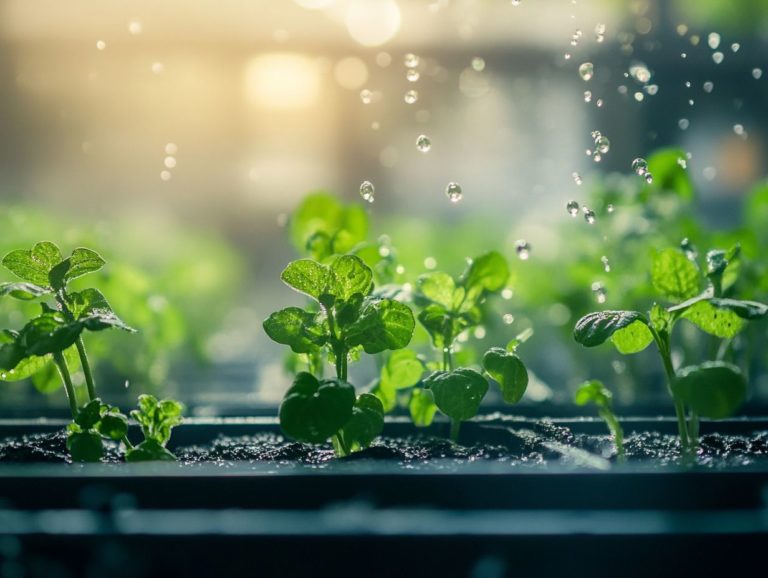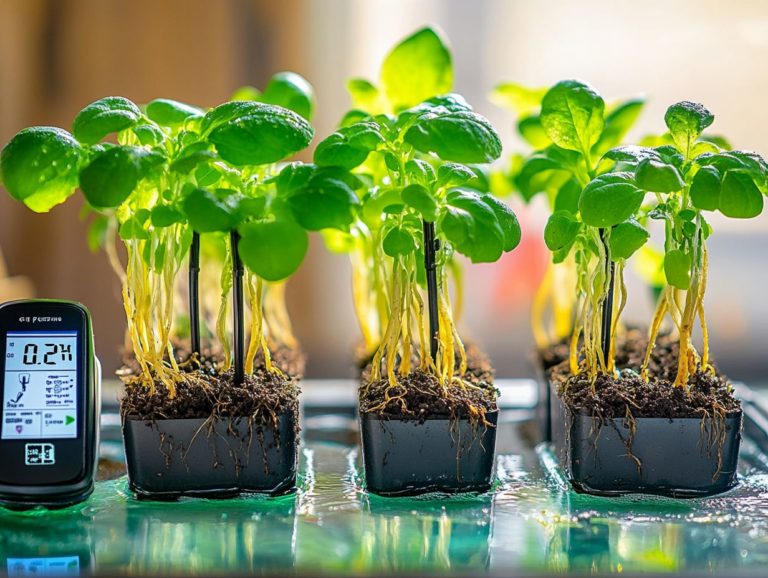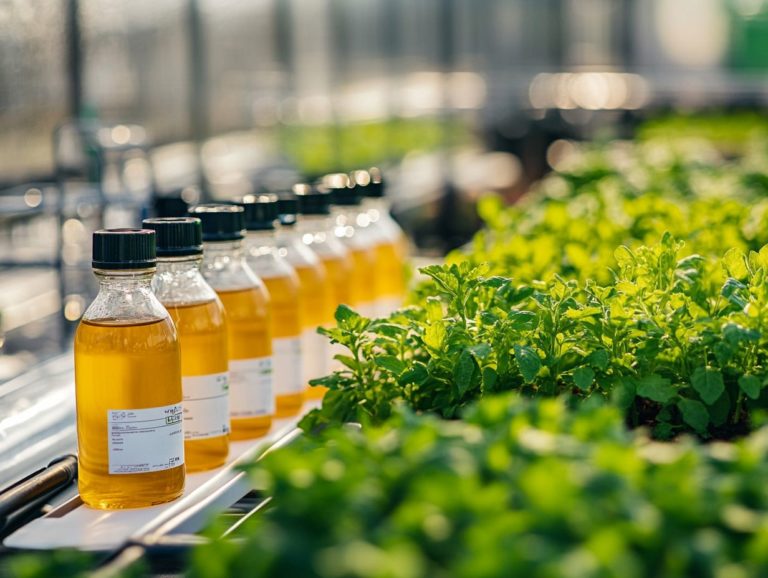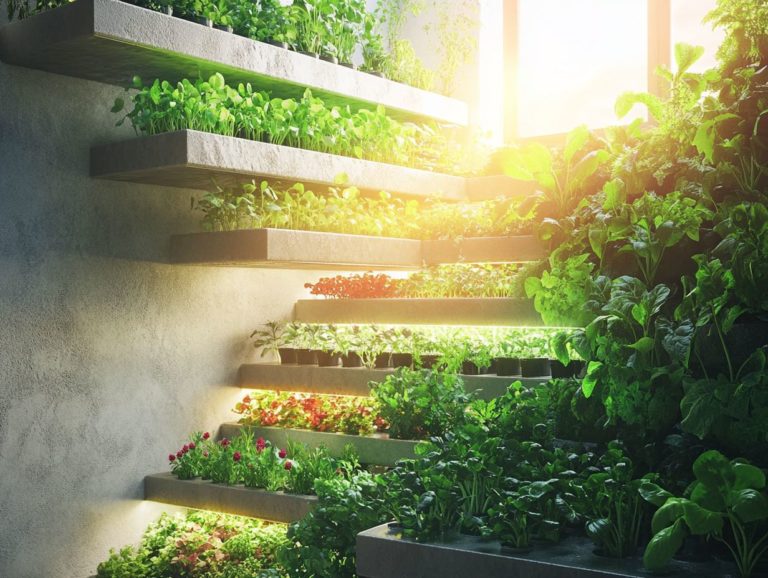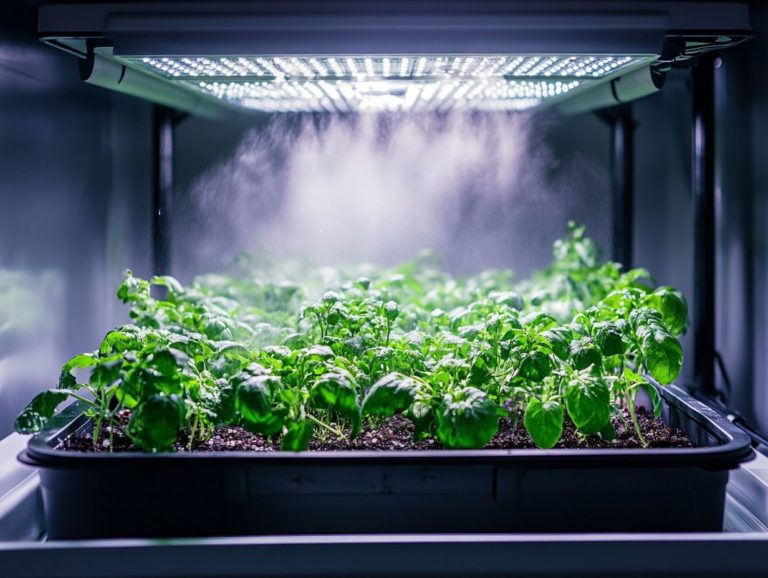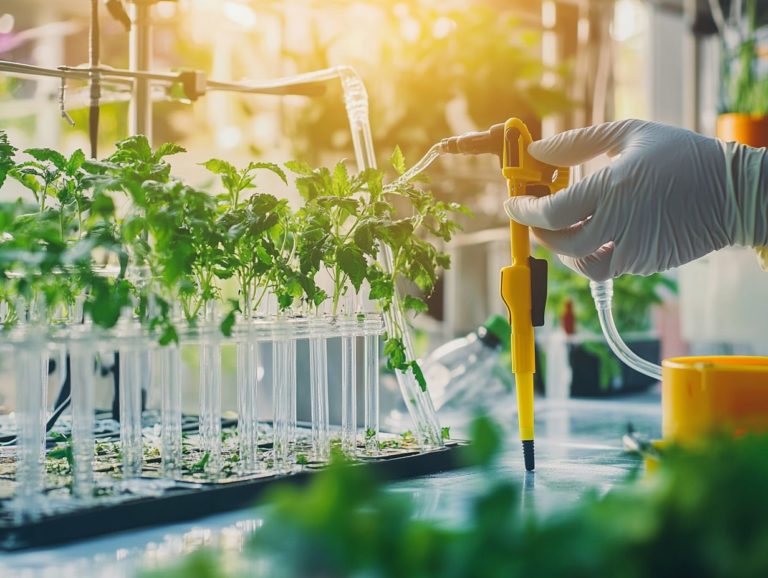How to Choose a Hydroponic Kit?
Hydroponic gardening is revolutionizing the way you cultivate plants, presenting a soil-less solution that is both efficient and innovative. Get ready to explore everything you need to know about hydroponic gardening!
This guide highlights the advantages hydroponic kits offer over traditional gardening methods and essential considerations for selecting the perfect kit for your needs.
From gaining insights into various types of hydroponic systems, including the Wick System and Nutrient Film Technique, to receiving practical setup and maintenance tips, this guide equips you with all the information necessary to embark on your hydroponic journey.
Uncover the future of home gardening and elevate your planting experience!
Contents
- Key Takeaways:
- What is a Hydroponic Kit?
- Benefits of Using a Hydroponic Kit
- Key Factors for Picking Your Perfect Hydroponic Kit
- Types of Hydroponic Kits for Sustainable Indoor Gardening
- Aeroponics
- How to Set Up and Maintain a Hydroponic Kit
- Step-by-Step Guide
- Maintenance Tips
- Frequently Asked Questions
- 1. How do I know which type of hydroponic kit is best for me?
- 2. Can I use any type of container for my hydroponic system?
- 3. What is the difference between an ebb and flow system and a deep water culture system?
- 4. Is it necessary to use grow lights in a hydroponic system?
- 5. Can I customize my hydroponic kit to fit my specific needs?
- 6. How do I maintain my hydroponic system?
Key Takeaways:

- Consider size, space, and budget when choosing a hydroponic garden.
- Explore different types of hydroponic kits, such as deep water culture (similar to the Kratky method), ebb and flow, drip system, and aeroponics.
- Follow a step-by-step guide and regular maintenance tips to ensure successful setup and maintenance of your hydroponic kit.
What is a Hydroponic Kit?
A hydroponic kit is your gateway to growing plants without the hassle of soil. It utilizes methods like water culture and nutrient solutions that can range from nutrient film to drip irrigation, along with innovative technologies such as the AutoPot system. This system is known for its efficiency in water usage and plant management.
Hydroponics elevates plant growth by creating optimal conditions tailored to each plant’s specific needs, delivering nutrient-rich solutions directly to the roots.
These kits come equipped with essential components, including various growing media like perlite and vermiculite, making them perfect for both novices and experienced indoor gardening enthusiasts.
Each type of growing media offers its own advantages, ensuring proper drainage and air circulation while retaining moisture. Nutrient solutions, packed with key minerals and tailored to maintain optimal pH levels like nitrogen, phosphorus, and potassium, provide the sustenance plants need to thrive.
You can explore various hydroponic methods, like the Ebb and Flow or Wick System. This allows you to select a setup that aligns perfectly with your space and maintenance preferences. The Ebb and Flow method optimizes oxygen access by periodically flooding the growing area, while the Wick System nourishes plants continuously through the way water moves through plants.
These techniques not only promote efficient resource use but also foster robust, healthy growth.
Benefits of Using a Hydroponic Kit
Using a hydroponic kit presents a wealth of benefits, whether you’re just starting out or have a seasoned green thumb. You can enjoy increased sustainability, efficient resource utilization, and the remarkable ability to grow a diverse array of plants indoors all year round regardless of weather conditions.
Hydroponics significantly reduces water usage compared to traditional gardening. It provides precise control over nutrient delivery, minimizes soil-borne diseases, and accelerates plant growth by optimizing environmental conditions. With the integration of smart technology into these systems, monitoring and managing your indoor garden becomes more accessible and efficient than ever before.
Start your hydroponic journey today and transform your gardening experience!
Advantages of Hydroponics
Hydroponics offers a range of advantages over traditional gardening. It significantly reduces the risk of root rot caused by pesky pathogens like pythium.
With techniques like nutrient film and drip irrigation, you will enhance nutrient absorption through efficient water management that traditional methods simply can’t match.
By eliminating soil, you cut down the chances of encountering soil-borne pests and diseases. This promotes healthier plant growth and, ultimately, higher yields.
Hydroponic systems can be meticulously fine-tuned to provide optimal light intensity and nutrient solutions. This creates an ideal environment for plants to flourish without the constraints of soil-based gardening.
In contrast, traditional gardening often struggles with inconsistent soil quality and the unpredictability of weather conditions, which can hinder plant development and yields.
Hydroponics excels in resource management, using up to 90% less water than conventional farming methods, promoting greater sustainability.
Techniques like the Ebb and Flow system demonstrate this efficiency. They allow for precise control over water and nutrient delivery, ensuring your plants receive exactly what they need when they need it.
This leads to faster growth cycles and less waste. Join the growing number of gardeners discovering the benefits of hydroponics!
Key Factors for Picking Your Perfect Hydroponic Kit
When selecting the ideal hydroponic kit, consider several crucial factors:
- The system’s size
- The available space
- The types of plants you want to grow
- Your overall budget for indoor gardening
Understanding the intricacies of plant management and the specific requirements of different hydroponic systems will guide you to the most suitable kit.
It’s vital to evaluate your indoor environment, considering elements like light availability and water access, as these significantly impact your gardening success.
Size and Space
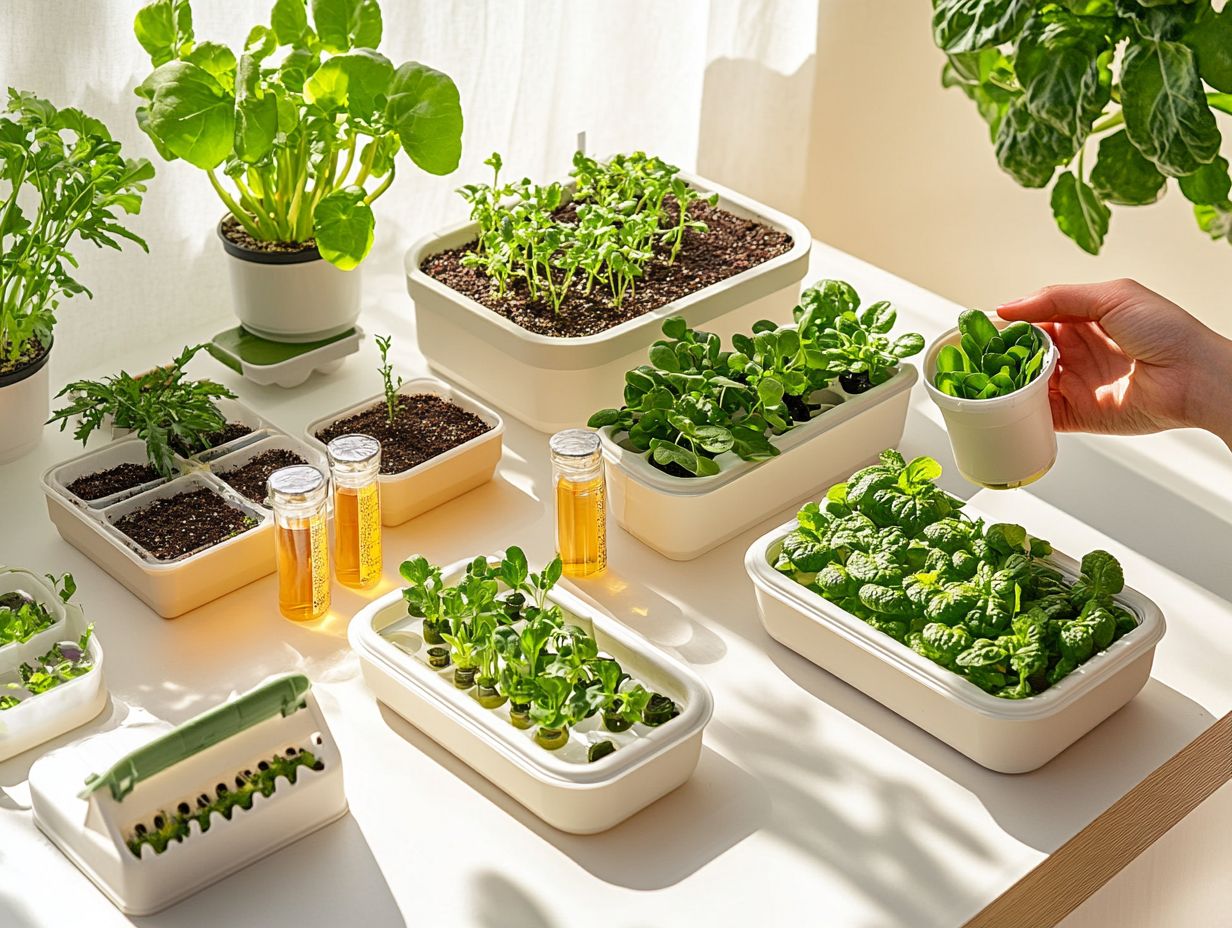
Understanding the size and space requirements of various hydroponic kits is crucial for maximizing yield through careful planning.
This directly influences plant management and growth potential. If you’re working with limited space, a compact hydroponic garden might be perfect for you, while larger systems can accommodate a broader range of plants.
By assessing your available space, you ensure your setup is both functional and productive, allowing you to maximize yield.
Consider vertical gardening as a game-changer. It enhances productivity by allowing you to grow upwards instead of outwards, maximizing every precious square inch.
For cultivating herbs or leafy greens, smaller setups with shallow containers and lighter growing media are ideal. These plants thrive in such environments.
If you aim to nurture larger plants like tomatoes or peppers, larger hydroponic systems will provide deeper growing beds, offering ample support and nutrient access.
Start your hydroponic journey today and watch your garden thrive!
Types of Plants
The types of plants you choose to grow and their specific light intensity requirements in a hydroponic system will greatly influence your seed selection. Popular options include tomatoes and peppers, both of which flourish in nutrient-rich environments.
Hydroponics allows you to grow a wide variety of plants, from leafy greens to aromatic herbs. These plants benefit from the controlled conditions that hydroponic systems offer, including precise adjustments to light intensity and nutrient solutions.
Understanding which plants best align with your chosen hydroponic method will significantly enhance your chances of success and satisfaction. For more detailed guidance, check out this guide on choosing the right hydroponic system for DIY. Each plant species has unique requirements regarding light spectrum, duration, and intensity, which can influence your hydroponic setup.
For example, leafy vegetables tend to require less light compared to fruiting plants like cucumbers or strawberries, which thrive under more intense lighting conditions. Your choice of growing media whether it s coconut coir or rock wool will also vary based on the type of plant.
Some plants appreciate more moisture retention, while others thrive in conditions with excellent drainage. By syncing your hydroponic system with the specific needs of your chosen plants, you can optimize growth and yield, ensuring a truly fruitful gardening experience.
Budget
Establishing a budget is a vital step in your journey toward selecting the right hydroponic kit with smart technology features. Costs can differ dramatically based on the type of system and any smart features you might want. By understanding your financial limits, you can confidently choose between advanced setups like the AutoPot system or simpler kits that require a lighter initial investment.
No matter your budget, choosing a system that meets your gardening goals can lead to impressive savings in resources and enhanced yields over time.
Entry-level systems often start around $50, making them perfect for beginners eager to dabble without making a hefty commitment. For something more robust, mid-range options, priced between $150 and $500, typically offer better pumps, grow lights, and tools for managing nutrients, creating a thriving growing environment.
If you’re ready to invest upwards of $1,000, you’ll discover fully automated systems equipped with integrated monitoring capabilities that can significantly simplify your gardening experience. Weighing these initial costs against potential long-term benefits such as reduced water usage, quicker growth cycles, and superior crop quality will enable you to make a well-informed decision that aligns perfectly with your gardening ambitions.
Types of Hydroponic Kits for Sustainable Indoor Gardening
Several types of hydroponic kits await your exploration. Each employs distinct methods like Deep Water Culture, Ebb and Flow, Nutrient Film Technique, Drip Irrigation, and Aeroponics to cater to your gardening preferences and plant types.
Each method boasts unique advantages. For instance, the Wick System offers simplicity, while Aeroponics delivers advanced capabilities that optimize oxygen and nutrient delivery. By grasping the nuances of these systems, you can select the hydroponic setup that best aligns with your needs, leading to healthier plants and more efficient growth.
Start your hydroponic journey today for a successful and rewarding gardening experience!
Deep Water Culture
Deep Water Culture (DWC) is an exceptional hydroponic method that allows you to immerse plant roots in a nutrient solution, ensuring optimal oxygenation and nutrient uptake. This technique is particularly well-suited for a variety of plants and makes plant management easy with minimal intervention. It delivers essential nutrients directly to the roots, making DWC especially effective for fast-growing plants.
In this method, you fill a reservoir with oxygen-rich nutrient solution, guaranteeing that your plants receive everything they need to flourish. The buoyant nature of the setup promotes optimal root development and paves the way for high yields.
Ideal candidates for your DWC garden include leafy greens, herbs, and even small fruiting plants like strawberries. These plants thrive on consistent moisture and quick access to essential nutrients. By maintaining the right pH balance and monitoring nutrient concentration, you can foster vigorous growth, leading to bountiful harvests.
Ebb and Flow
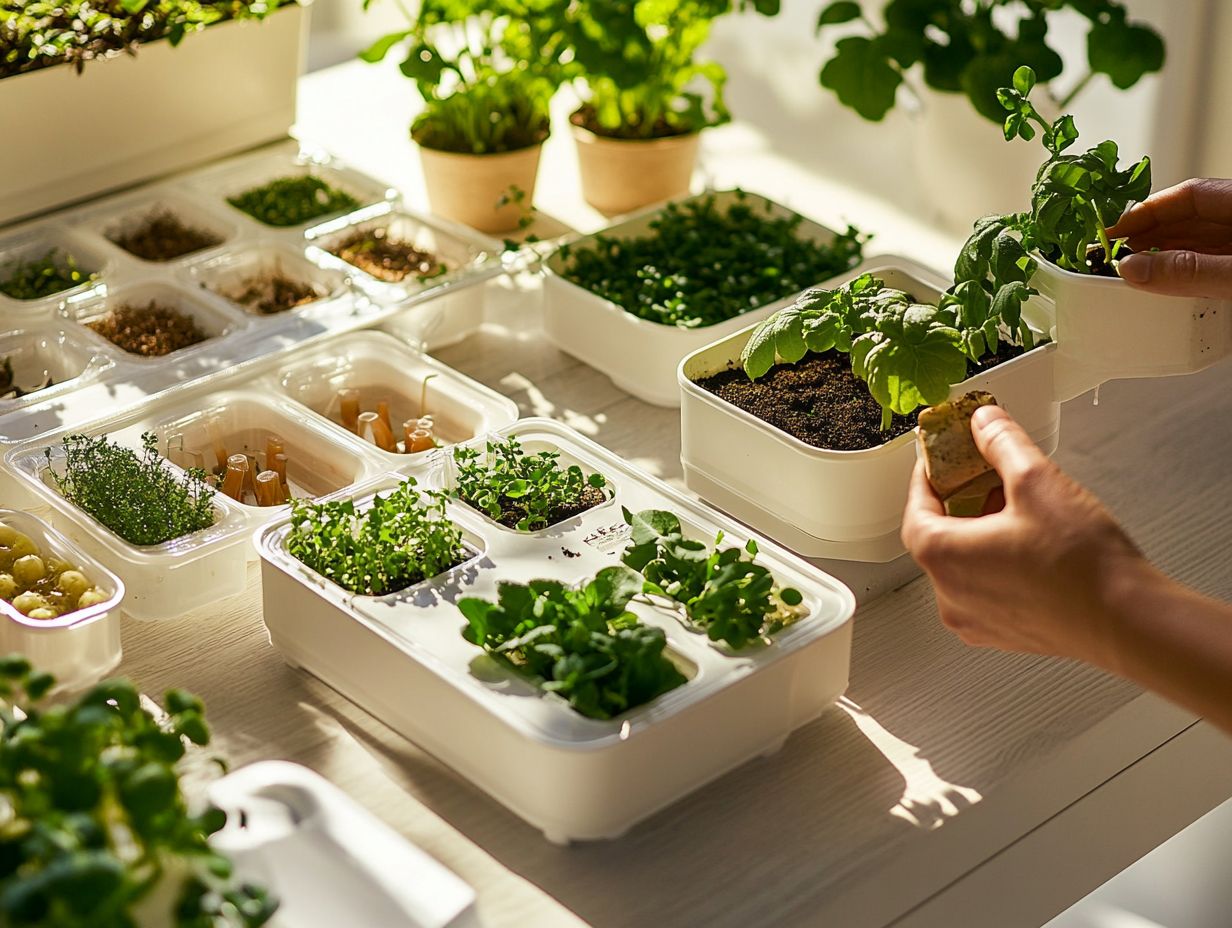
The Ebb and Flow system, often called flood and drain, uses capillary action to periodically inundate your grow tray with a nutrient solution before draining it. This cycle allows the roots to absorb essential nutrients while getting a breath of fresh air.
This method is great for promoting robust root development, particularly for plants that thrive in well-aerated conditions. With its versatility, the Ebb and Flow system can accommodate a wide variety of plants, making it a preferred choice among hydroponic gardeners.
By alternating between flooding and draining, this system ensures that your plants roots are saturated with vital nutrients while also receiving ample oxygen. This balance is crucial for their growth. The Ebb and Flow system is particularly well-suited for cultivating leafy greens like lettuce and herbs, which prefer moist yet well-aerated root environments. It also supports fruiting plants like tomatoes and peppers, promoting vigorous growth.
Hydroponic enthusiasts will appreciate how easy it is to manage nutrient availability and water levels, leading to healthier plants and potentially higher yields.
Drip System
Drip irrigation is an exemplary hydroponic method that delivers a nutrient solution directly to the root zone through a network of tubes and emitters. This approach gives you precise control over both water and nutrient delivery, minimizing waste while maximizing efficiency perfect for a diverse array of plants.
By incorporating smart technology, you can elevate the performance of your drip system and enable real-time monitoring and adjustments to optimize plant health. Embracing this advanced irrigation technique is a must for curtailing water usage while ensuring that each plant receives the essential nutrients necessary for robust growth.
The targeted water delivery method effectively reduces the risk of disease as moisture is confined to the root area. Crops like tomatoes, cucumbers, and peppers flourish in these conditions, benefiting from a steady supply of tailored nutrients.
This system champions sustainable farming practices and contributes to increased yields and healthier produce. Start your hydroponic journey now and enjoy the benefits of fresh, home-grown produce!
Aeroponics
Aeroponics is a new way to grow plants without soil. Imagine this: plant roots suspended in air. They are periodically misted with a nutrient solution, ensuring exceptional oxygenation and nutrient absorption.
This method also maximizes light exposure, promoting rapid growth. It’s great for valuable crops while using minimal resources.
By eliminating the need for soil, this innovative approach gives you greater control over nutrient delivery, encouraging healthier and faster-growing plants. Compared to traditional hydroponic systems, aeroponics is more efficient with water and nutrients, reducing waste and enhancing sustainability.
Leafy greens, herbs, and strawberries thrive in this system, as their roots directly absorb those misted nutrients. Not only does this technique boost crop yield, but it also supports an eco-friendly philosophy in modern agriculture.
How to Set Up and Maintain a Hydroponic Kit
Setting up and maintaining a hydroponic kit requires careful attention to detail. Ensure that every component from the nutrient solution to the environmental conditions is finely tuned for optimal plant growth.
Proper setup begins with selecting the right system and preparing the growing media. For those new to hydroponics, understanding how to get started with hydroponic systems is essential. Regularly check the pH with a pH meter. Maintenance is crucial for your long-term success; routine checks on nutrient levels and system cleanliness will profoundly influence the health and yield of your hydroponic garden.
Step-by-Step Guide
A step-by-step guide to setting up a hydroponic kit streamlines the process. Start by selecting the hydroponic system that suits your needs and gather all necessary materials, including a nutrient solution tailored specifically for your plants.
By following the assembly instructions and monitoring key factors like pH levels and nutrient concentrations, you ll establish a solid foundation for your hydroponic garden.
Choose the right system whether it’s deep water culture, nutrient film technique, or aeroponics. Each offers unique benefits. For beginners looking to get started, you can explore the best hydroponic systems. Establish a schedule for maintenance checks, including replenishing the nutrient solution and cleaning the reservoir to prevent algae growth.
Keeping an eye on environmental factors such as light, temperature, and humidity is essential. Many beginners overlook the importance of adjusting these factors promptly, which can lead to poor plant health or even system failure.
Stay proactive and well-informed to sidestep common pitfalls and cultivate thriving plants in this innovative growing setup.
Maintenance Tips
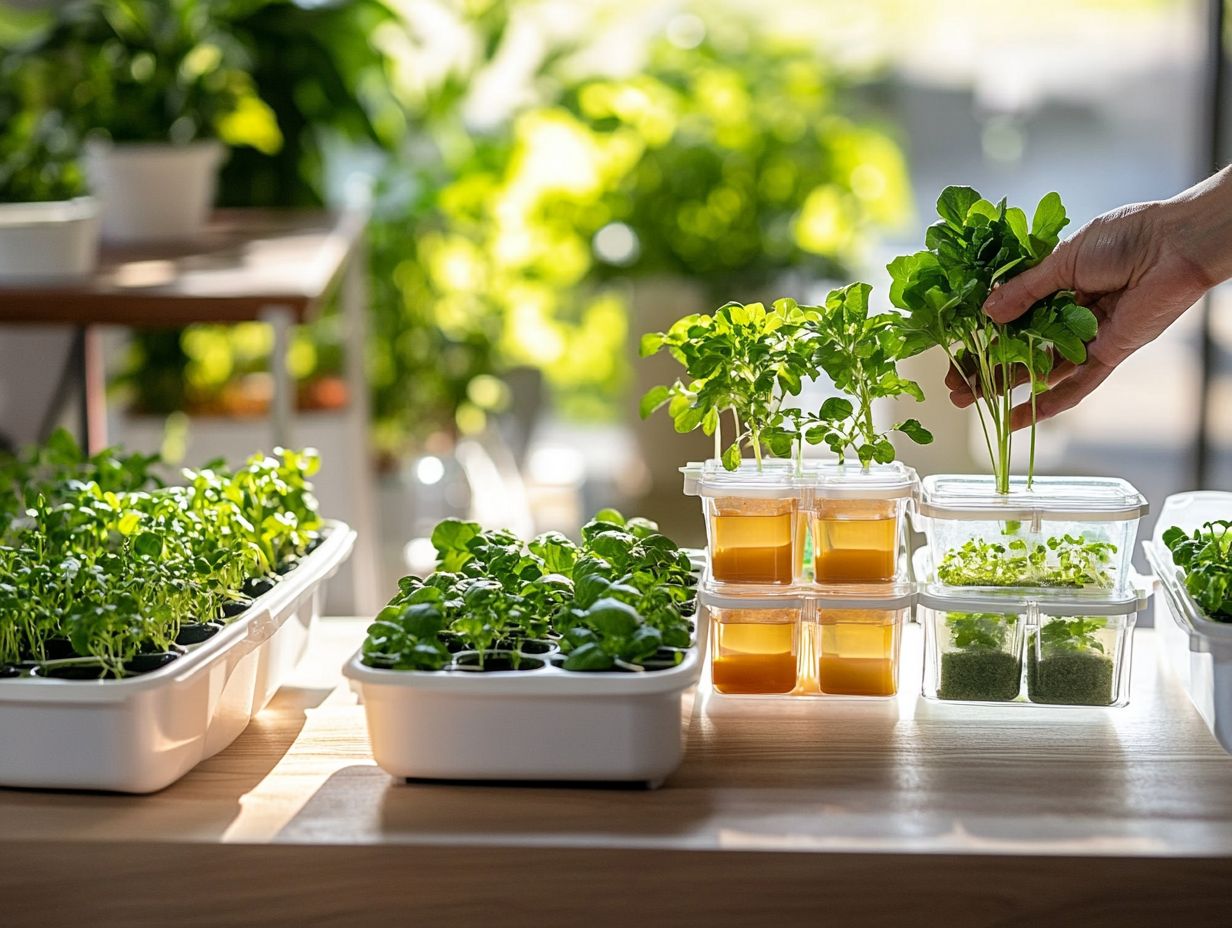
Regular maintenance is crucial for your hydroponic garden’s success. It helps avoid issues like root rot and ensures your plants consistently receive the right nutrient solution.
Monitor pH levels with a reliable pH meter and check nutrient concentrations regularly to maintain optimal growth conditions.
Cleaning the system and inspecting for pests or diseases will significantly contribute to overall plant health and yield. Routinely assess nutrient uptake and adjust your solutions as needed.
Establish a cleaning schedule; removing algae or buildup keeps your system performing at its best. Remember, fluctuations in environmental factors can impact pH balance and nutrient availability, so frequent checks are essential.
Investing in quality test kits simplifies your monitoring process and enhances your ability to prevent potential issues before they escalate. Nurturing a healthy hydroponic environment leads to a robust and productive garden, ensuring your hard work pays off.
Follow these tips to keep your hydroponic garden healthy and flourishing!
Frequently Asked Questions
Got more questions? Reach out and let s grow together!
1. How do I know which type of hydroponic kit is best for me?
The best way to choose a hydroponic kit is to consider your needs and preferences. Do you want to grow a specific type of plant or do you have limited space? Answering these questions helps narrow your options. This way, you ll find the perfect kit.
2. Can I use any type of container for my hydroponic system?
You can use various containers, but choose one that s the right size for your plants and allows drainage. It s best to use containers designed for hydroponics to ensure great results.
3. What is the difference between an ebb and flow system and a deep water culture system?
An ebb and flow system floods plants with nutrients at intervals. In contrast, deep water culture keeps the roots soaked. Ebb and flow works better for plants that like drier conditions, while deep water culture suits those needing constant moisture.
4. Is it necessary to use grow lights in a hydroponic system?
Natural light is ideal, but indoor hydroponic systems often lack enough light. Grow lights are beneficial in this case, helping your plants thrive. Special types of grow lights are available for hydroponic systems to provide the right light spectrum.
5. Can I customize my hydroponic kit to fit my specific needs?
Many hydroponic kits come ready to use, but you can customize them. Add or remove components like grow lights or timers. You can even build your own system. Research and consult with experts to ensure it works properly.
6. How do I maintain my hydroponic system?
Keeping your hydroponic system running smoothly is essential for plant health. Regularly check nutrient levels, clean the system, and watch for issues. Follow the maintenance instructions that come with your kit for best results.

